Review for In This Corner Of The World
Introduction
We’re hitting peak anime again. There’s more of the stuff streaming than ever before, and licensing and production costs are getting ridiculous once more. And a lot of it is the lowest, common denominator, fan service stuff that seems to blend into one. It’s that point where if you really want to licence a decent property, you have to spend a lot more than you might have hoped, and if you’re going to spend that much, you might as well make it, or at least invest in it. Quite recently, Netflix announced that they’d be ‘making’ ten anime shows, and while that route isn’t always successful (the less said about ADV’s Samurai Gun and Lady Death the better), once in a while it can be a decision that literally makes a company. Way back at the end of the nineties, Manga Video invested in a movie called Ghost in the Shell. They’re at it again now, with the Animatsu name prominent in the production credits for In This Corner of the World, the Second World War movie from Sunao Katabuchi, director of Black Lagoon and Mai Mai Miracle.
You might be wondering why we need another Second World War anime movie, or to be more precise another such movie that looks at the everyday life and hardship of civilians in Japan as the war comes to an end. After all, the name on everyone’s lips at this point is Grave of the Fireflies, Studio Ghibli’s masterpiece tale of two forgotten children in wartime Japan. On top of that are the autobiographical Barefoot Gen movies, the anime recounting of the Hiroshima bombing and its aftermath. And when I tell you that In This Corner of the World too is set in and around Hiroshima, you might begin to think it’s redundant. But it turns out that there is a place for this film, a very important place in the canon.
Suzu Urano grew up in a village near Hiroshima, the middle child of three siblings, with an older brother and a younger sister. She was an absent minded child, but she did have an amazing talent for art and telling tall stories. She reached her 18th birthday in 1943, and a match was made for her, a marriage that took place the following spring in the naval port town of Kure. Her new life with her new family certainly took some getting used to, especially with a critical sister in law, but gradually she found new joy in her life. Yet as the war draws to its close, the people of Kure face ever greater hardships, first in the form of rationing and conscription... and then the air raids begin.
For the purposes of this review, I’m looking at the DVD disc, although it’s also available on BD/DVD combo, and a collector’s edition with a production booklet and extra features.
Picture
The DVD gets a 1.85:1 anamorphic PAL transfer. The image is clear and sharp throughout, and scales up without issue to an HD panel. In This Corner of the World boasts some beautiful artwork, doubly so given the quality of the animation, and Suzu’s artistic tendencies so often demonstrated in the film. The gentle and warm palette combines with appealing character designs, while the way the animators capture the quirks and mannerisms of the characters is really quite appealing.
Sound
You have the choice between DD 5.1 Surround English and Japanese, with optional English subtitles. There is no signs and lyrics track, rather onscreen text and song lyric translations are burnt into the print. That’s a fair solution for the usual Manga authoring problem with multiple subtitle captions on screen at one time, but a couple of the burnt in captions aren’t on screen long enough either. The subtitles are timed accurately but I did spot the odd minor typo. It’s actually a mostly dialogue focussed film, but the surround does offer ambience and a little space for the film to breathe, while the rare moment of strident action comes across well. I was happy with the Japanese audio, but what little I sampled of the English dub seemed of decent quality as well.
Extras
You get an animated menu on this disc, and the film is followed by two pages of translated English credits, in a font that’s too small and blurry to read via the DVD. It’s probably clear on the Blu-ray though. If the Blu-ray is identical to the DVD, then the only extras you’ll see are the physical extras. The bonus DVD disc with an hour of featurettes is exclusive to the Collector’s Edition release.
Conclusion
There very much is a place for In This Corner of the World in the anime canon. It’s a splendid, breathtaking film that offers a different, and much needed perspective to the Japanese experience of World War II, a perspective that will certainly have resonance because the experience of its characters is so universal. Both Barefoot Gen and Grave of the Fireflies, important films though they are, are primarily anti-war polemics, and relentless narratives of increasing tragedy. In This Corner of the World is a more relatable story, as it quite rightly observes that for the non-combatant civilian in wartime, life goes on, that no matter the setback, or the momentary tragedy, life will continue as normally as possible under the circumstances.
In This Corner of the World is then a slice-of-life anime, which happens to be set during the Second World War. It’s Suzu’s story, which here begins in 1933, with her as the middle child of a family that makes its living harvesting seaweed. We get brief snippets of her home life as she grows up, giving us an insight into her personality, and the joy that she has with her family. Of course the idyllic Japan of her childhood has become more militarised and imperialistic by the time she’s old enough to marry, and moving to Kure, a naval base to be with her husband and his extended family, takes her closer to the action, so to speak.
The story is still about her personal life though, getting to know her in-laws, and slowly falling in love with her husband (it was an arranged marriage), and while the sense of the war is evident (she gets in trouble one day for sketching the wrong thing), it’s still feels like everyday life. It’s everyday life with rationing, with air raid drills, with military police, but these are lesser concerns than fitting into her new family, getting on with her sister-in-law, having fun with her niece, paying the odd visit home to her parents. But then the rationing gets stricter, to the degree where the home garden is an essential rather than a supplement, to where trips to the black market become necessary. But life still goes on. Then the air raids begin, they have to dig a bomb shelter into the hill, but life goes. The bombing intensifies, but life goes on. Her husband is conscripted, but once again, life goes on. And with the war coming ever closer to Japan, inevitably personal tragedies occur too, but as is the motif of this film, life does go on. The in between moments are about keeping calm, carrying on, a blitz spirit that will be all too familiar.
Anti-war messages in such films as these can be as obvious as the depth of personal tragedies caused by war, but In This Corner of the World has another string to its bow, that of the commonality of the experience. Anyone who’s read about the war from the British perspective, the double threat of rationing and the Blitz will see much here that is familiar. Where this film really succeeds though is in its focus on the normal, the everyday life. People still lived during the war, they took joy in their communities and their families, they still strived to improve their lots, and as always it was the minutiae of their everyday life that took precedence, not the bigger picture. The joy and hope in this film makes the tragedies stand out with even harsher contrast, and that makes this film so much more effective. But what you’re left with at the end of In This Corner of the World is the sense of hope, which in my experience with anime films of this genre is unique.
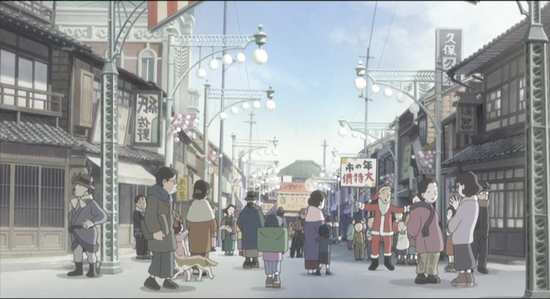
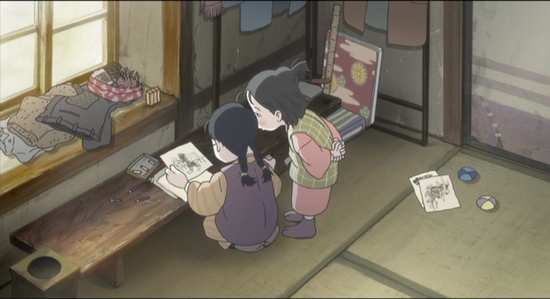
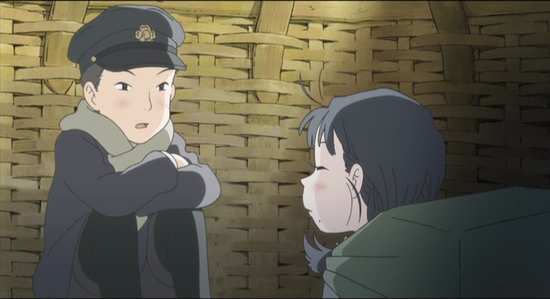
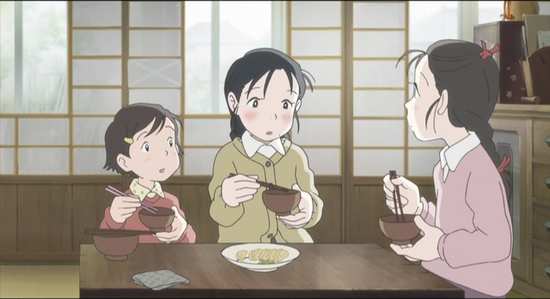
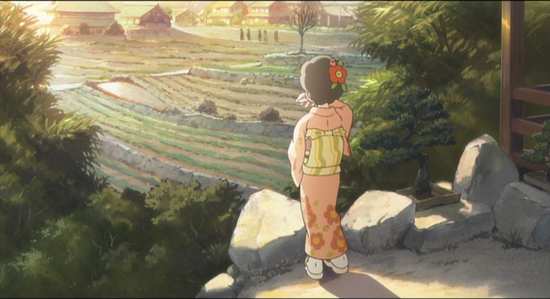
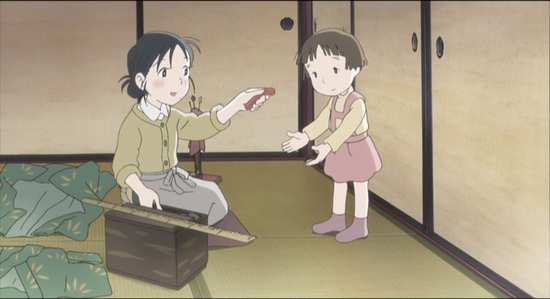
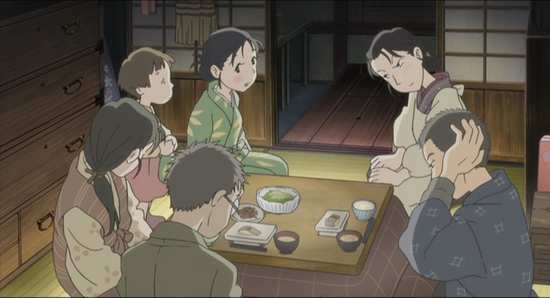
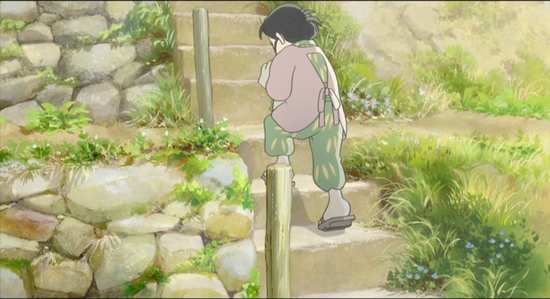
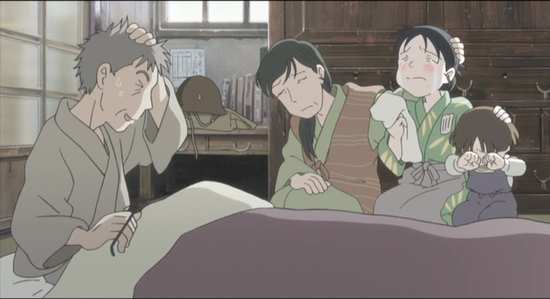
Your Opinions and Comments
Be the first to post a comment!